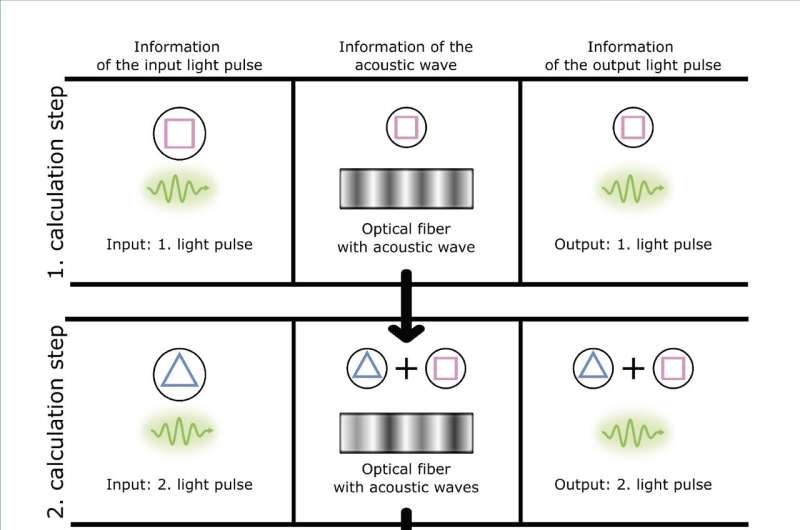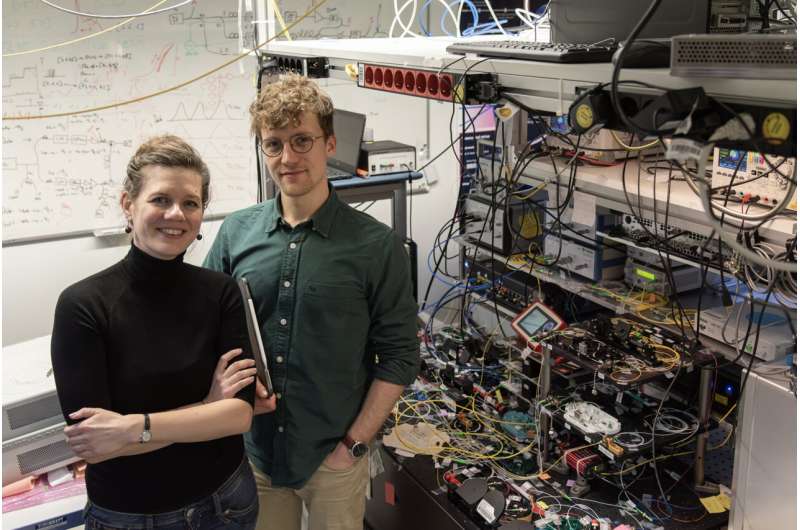Artist’s impression of photoacoustic computing. Image source: Long Huy Dao
Optical neural networks can provide the high-speed and high-capacity solutions needed to solve challenging computing tasks. However, realizing its full potential requires further progress. One challenge is the reconfigurability of optical neural networks.
A research team from Stiller’s group at the Max Planck Institute for Light Science, in collaboration with Englund’s group at MIT, has now succeeded in building a new model for a new neuromorphic system by adding new reconfigurable neuromorphic building blocks. Reconfigurable neuromorphic construction modules lay the foundation for the next dimension of photonic machine learning: sound waves.Their findings were published in nature communications.
The researchers used light to generate temporary sound waves in optical fibers. Sound waves generated in this way can perform repetitive functions in telecommunications optical fibers, which is crucial for interpreting contextual information such as language.
Artificial intelligence is now commonplace and helps us with everyday tasks. Language models like ChatGPT help us reduce administrative overhead by creating naturally expressive text and summarizing paragraphs in a structured way. The disadvantage is that they require huge amounts of energy, which means that as they evolve, these smart devices will require new solutions to speed up signal processing and reduce energy consumption.
Neural networks have the potential to become the backbone of artificial intelligence. Building them into optical neural networks based on light rather than electrical signals is expected to process large amounts of data at high speeds and efficiently. However, to date, many experimental approaches to implementing optical neural networks have relied on fixed components and stabilizing equipment.
Now, an international research team led by Birgit Stiller of the Max Planck Institute for Light Science, in collaboration with Dirk Englund of MIT, has found a way to create reconfigurable building blocks based on sound waves for photonic machine learning. In their experimental approach, the researchers used hair-thin optical fiber, which is already used for fast internet connections around the world.

The information carried by the light pulses is partially converted into sound waves. Even after the light pulse leaves the fiber, the message remains in the sound wave. Image source: Stiller Research Group, MPL
The key to the invention is the light-driven generation of traveling sound waves, which in turn controls the subsequent computational steps of the optical neural network. The optical information is processed and correlated with the sound waves. Sound waves travel much longer than light traffic. Therefore, they remain in the fiber longer and can be linked to each subsequent processing step in turn. What’s unique about this process is that it’s completely controlled by light and doesn’t require complex structures and sensors.
“I am delighted that we have embarked on this new field of research, pioneering the use of sound waves to control optical neural networks. Our results have the potential to inspire the development of novel building blocks for new photonic computing architectures,” said Birgit Stiller, Ph.D. Leader of the Quantum Photoacoustics Research Group.
The first building block the team demonstrated experimentally was the loop operator, a technique widely used in the field of recurrent neural networks. It allows linking a sequence of computational steps, thus providing context for each computational step performed.

Dr. Birgit Stiller and Steven Becker in the lab. Photo credit: Susanne Viezens, MPL
For example, in human language, the order of words can determine the meaning of a sentence. For example, the two sentences “She decided to study the challenge” and “She decided to study the challenge” are composed of the same words, but have different meanings. This is because the order of the words creates different contexts.
Traditional fully connected neural networks on computers face difficulties in capturing context because they require access to memory. To overcome this challenge, neural networks are equipped with loop operations that enable internal memory and capture contextual information. While these recurrent neural networks are easy to implement digitally, similar implementations in optics are challenging and have so far relied on artificial cavities to provide memory.
Researchers have now used sound waves to implement loop operators. Therefore, the optoacoustic loop operator (OREO) exploits the inherent properties of optical waveguides without the need for artificial reservoirs or newly fabricated structures.
OREO has the advantage of complete optical control, enabling photoacoustic computers to be programmed on a pulse-by-pulse basis. For example, researchers used it for the first time to achieve optical loop loss, a conditioning technique previously only used to improve the performance of digital recurrent neural networks. OREO has been used to distinguish up to 27 different patterns, demonstrating its ability to handle situations.
“OREO’s all-optical control is a powerful feature. Especially the possibility to program the system on a pulse-by-pulse basis, providing several additional degrees of freedom. Using sound waves for photonic machine learning is disrupting the status quo and I’m excited about it Very eager to see how this field will develop in the future,” said Steven Becker, a doctoral student in Stiller’s lab.
In the future, using sound waves in optical neural networks could unlock a new class of optical neuromorphic computing that can spontaneously reconfigure and allow large-scale in-memory computing within current telecommunications networks. Furthermore, on-chip implementation of optical neural networks could benefit from this approach, which can be implemented in photonic waveguides without the need for additional electronic control.
“Photonic machine learning may have great potential for parallel processing of information and energy-efficient operation. Adding sound waves through a fully optically controlled and easy-to-operate tool kit can contribute to this effort,” said Dr. Birgit Stiller.
More information:
Steven Becker, Dirk Englund and Birgit Stiller, Photoacoustic field-programmable perceptrons for recurrent neural networks, nature communications (2024). doi:10.1038/s41467-024-47053-6. www.nature.com/articles/s41467-024-47053-6
Courtesy of the Max Planck Institute for Light Science
citation: Photonic Machine Learning Using Sound Waves: Research Lays the Groundwork for Reconfigurable Neuromorphic Building Blocks (2024, April 16), Retrieved April 21, 2024, from https://techxplore.com/news/2024-04 -photonic-machine-lays-foundation-reconfigurable.html
This document is protected by copyright. No part may be reproduced without written permission except in the interests of fair dealing for private study or research purposes. Content is for reference only.
#Photonic #machine #learning #sound #waves #Study #lays #foundation #reconfigurable #neuromorphic #building #blocks
Image Source : techxplore.com
